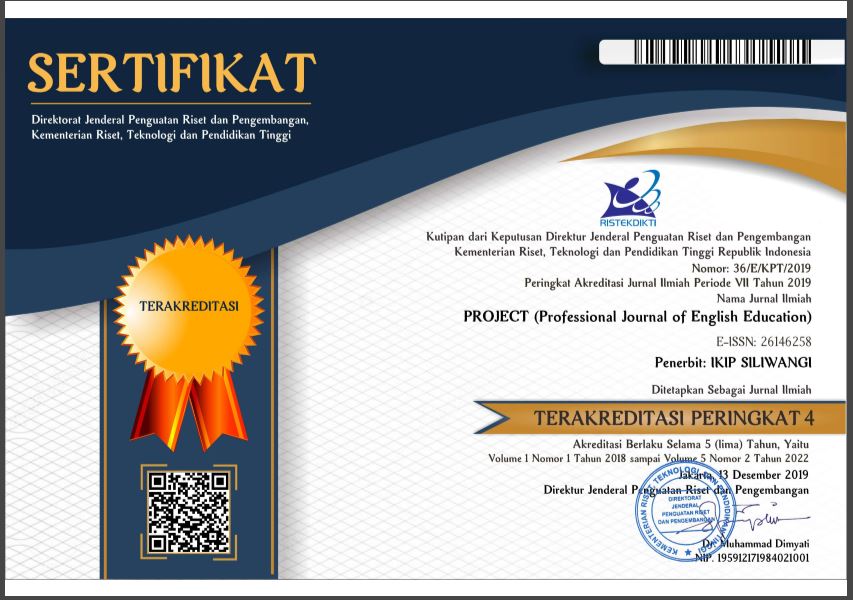PORTRAYING HIGH FOREIGN LANGUAGE LISTENING ANXIETY STUDENTS’ ENGAGEMENT IN THE IMPLEMENTATION OF NARROW LISTENING
Abstract
The article aims at portraying the learning engagement of high foreign language listening anxiety students in the implementation of narrow listening. The participants of the study consist of 42 English language education students with high foreign language listening anxiety of a private teacher training and education college in Jawa Timur province. This study used a case study method to observe the phenomenon of a listening activity. The data were collected through observation technique by using field notes. The collected data were then analyzed by using coding analysis. The results show that students have positive and negative behavioral, emotional and cognitive engagement dimensions.
References
Anderson, J. R. (1990). Cognitive Psychology and Its Implications: Third Edition. New York: Freeman.
Braun, V., & Clarke, V. (2006). Using thematic analysis in psychology. Qualitative Research in Psychology, 3(2), 77–101. https://doi.org/10.1191/1478088706 qp063oa
Budiharso, T. (2014). Reading strategies in EFL classroom: A theoretical review. CENDEKIA, 8(2), 189-204. Doi: https://doi.org/10.30957/cendekia.v8i2.63
Chang, A. C-S., & Read, J. (2006). The effects of listening support on the listening performance of EFL learners. TESOL Quarterly, 40(2), 375-397. Doi: https://doi.org/10.2307/40264527
Chang, A. C-S. (2010). Second-language listening anxiety before and after a 1-yr. intervention in EL compared with standard foreign language instruction. Perceptual and Motor Skills, 110(2), 355-365. Doi: http://dx.doi.org/10.2466/ pms.110.2.355-365
Chang, A. C-S., & Millett, S. (2014). The effect of extensive listening on developing L2 listening fluency: Some hard evidence. ELT Journal, 68(1), 31–40. Doi: https://doi.org/10.1093/elt/cct052
Chang, A. C-S., & Millet, S. (2016). Developing L2 listening fluency through extended listening-focused activities in an extensive listening programme. RELC Journal, 47(3), 349-362. Doi: https://doi.org/10.1177/0033688216631 175
Field, J. (2008). Listening in the Language Classroom. Cambridge: Cambridge University Press.
Firdaus, F., & Fatimah, S. (2021). Students’ engagement in learning English during the practice of teacher-in-role. Journal of English Language Teaching, 10(4), 554-565. Doi: https://doi.org/10.24036/jelt.v10i4.114710
Fredricks, J. A., Blumenfeld, P. C., & Paris, A. (2004). School engagement: Potential of the concept: State of the evidence. Review of Educational Research, 74, 59-119.
Krashen, S. D. (1996). The case for narrow listening. System, 24(1), 97-100. Doi: https://doi.org/10.1016/0346-251X(95)00054-N
Kim, J. (2000). Foreign language listening anxiety: A study of Korean students learning English. Unpublished doctoral dissertation, University of Texas, Austin.
Lee, S-Y. (2007). Revelations from three consecutive studies on extensive reading. REL Journal, 38(2), 150-170. Doi: https://doi.org/10.1177/00336882070797 30
Mackey, A. & Gass, S. M. (2012). Research Methods in Second Language Acquisition: A Practical Guide. Malden, MA: Wiley-Blackwell.
Onoda, S. (2014). Investigating effects of extensive listening on listening skill development in EFL classes. The Journal of Extensive Reading in Foreign Languages, 1(1), 43–55.
Rahman, H., & Suryati, N. (2018). Authentic texts used by EFL vocational teachers in listening classes: are they suitable with learners’ needs? Jurnal Pendidikan: Teori, Penelitian, dan Pengembangan, 3(5), 566-574. Doi: http://dx.doi.org/10.17977/jptpp.v3i5.10994
Renandya, W. A., & Farrell, T. (2011). Teacher, the tape is too fast! Extensive listening in ELT. ELT Journal, 65(1), 52-59. Doi: http://dx.doi.org/10.1093/elt/ccq015
Vandergrift, L. (2012). Teaching interactive listening. In H. P. Widodo & A. Cirocki, Innovation and creativity in ELT methodology (pp. 1-14). New York: Nova Science.
Vogely, A. J. (1998). Listening comprehension anxiety: students’ reported sources and solutions. Foreign Language Annals, 31, 67-80. Doi: https://doi.org/10.1111/j.1944-9720.1998.tb01333.x
Vo, Y. (2013). Developing extensive listening for EFL learners using internet resources. Hawaii Pacific University TESOL Working Papers Series 11, 29-51. Retrieved from: https://www.hpu.edu/research-publications/tesol-working-papers/2013/02_YenVo2013 .pdf
Wang, L., & Renandya, W. A. (2012). Effective approaches to teaching listening: Chinese EFL teachers’ perspectives. The Journal of Asia TEFL, 9(4), 79–111.
Yeh, C-C. (2013). An investigation of a podcast learning project for EL. Language Education in Asia, 4(2), 135-149. Doi: http://dx.doi.org/10.5746/LEiA/ 13/V4/I2/A04/Yeh
Zhang, W. (2005). An investigation of the effects of listening programmes on lower secondary students’ listening comprehension in PRC. Unpublished MA dissertation. SEAMEO Regional Language Centre, Singapore.
Downloads
Published
Issue
Section
License

This work is licensed under a Creative Commons Attribution-ShareAlike 4.0 International License.




